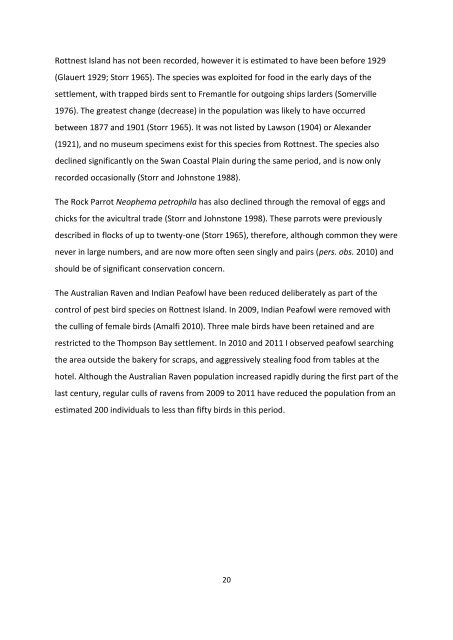Chapter 5 Feeding Ecology of the Australian Raven on Rottnest Island
Chapter 5 Feeding Ecology of the Australian Raven on Rottnest Island
Chapter 5 Feeding Ecology of the Australian Raven on Rottnest Island
Create successful ePaper yourself
Turn your PDF publications into a flip-book with our unique Google optimized e-Paper software.
<strong>Rottnest</strong> <strong>Island</strong> has not been recorded, however it is estimated to have been before 1929<br />
(Glauert 1929; Storr 1965). The species was exploited for food in <str<strong>on</strong>g>the</str<strong>on</strong>g> early days <str<strong>on</strong>g>of</str<strong>on</strong>g> <str<strong>on</strong>g>the</str<strong>on</strong>g><br />
settlement, with trapped birds sent to Fremantle for outgoing ships larders (Somerville<br />
1976). The greatest change (decrease) in <str<strong>on</strong>g>the</str<strong>on</strong>g> populati<strong>on</strong> was likely to have occurred<br />
between 1877 and 1901 (Storr 1965). It was not listed by Laws<strong>on</strong> (1904) or Alexander<br />
(1921), and no museum specimens exist for this species from <strong>Rottnest</strong>. The species also<br />
declined significantly <strong>on</strong> <str<strong>on</strong>g>the</str<strong>on</strong>g> Swan Coastal Plain during <str<strong>on</strong>g>the</str<strong>on</strong>g> same period, and is now <strong>on</strong>ly<br />
recorded occasi<strong>on</strong>ally (Storr and Johnst<strong>on</strong>e 1988).<br />
The Rock Parrot Neophema petrophila has also declined through <str<strong>on</strong>g>the</str<strong>on</strong>g> removal <str<strong>on</strong>g>of</str<strong>on</strong>g> eggs and<br />
chicks for <str<strong>on</strong>g>the</str<strong>on</strong>g> avicultral trade (Storr and Johnst<strong>on</strong>e 1998). These parrots were previously<br />
described in flocks <str<strong>on</strong>g>of</str<strong>on</strong>g> up to twenty-<strong>on</strong>e (Storr 1965), <str<strong>on</strong>g>the</str<strong>on</strong>g>refore, although comm<strong>on</strong> <str<strong>on</strong>g>the</str<strong>on</strong>g>y were<br />
never in large numbers, and are now more <str<strong>on</strong>g>of</str<strong>on</strong>g>ten seen singly and pairs (pers. obs. 2010) and<br />
should be <str<strong>on</strong>g>of</str<strong>on</strong>g> significant c<strong>on</strong>servati<strong>on</strong> c<strong>on</strong>cern.<br />
The <str<strong>on</strong>g>Australian</str<strong>on</strong>g> <str<strong>on</strong>g>Raven</str<strong>on</strong>g> and Indian Peafowl have been reduced deliberately as part <str<strong>on</strong>g>of</str<strong>on</strong>g> <str<strong>on</strong>g>the</str<strong>on</strong>g><br />
c<strong>on</strong>trol <str<strong>on</strong>g>of</str<strong>on</strong>g> pest bird species <strong>on</strong> <strong>Rottnest</strong> <strong>Island</strong>. In 2009, Indian Peafowl were removed with<br />
<str<strong>on</strong>g>the</str<strong>on</strong>g> culling <str<strong>on</strong>g>of</str<strong>on</strong>g> female birds (Amalfi 2010). Three male birds have been retained and are<br />
restricted to <str<strong>on</strong>g>the</str<strong>on</strong>g> Thomps<strong>on</strong> Bay settlement. In 2010 and 2011 I observed peafowl searching<br />
<str<strong>on</strong>g>the</str<strong>on</strong>g> area outside <str<strong>on</strong>g>the</str<strong>on</strong>g> bakery for scraps, and aggressively stealing food from tables at <str<strong>on</strong>g>the</str<strong>on</strong>g><br />
hotel. Although <str<strong>on</strong>g>the</str<strong>on</strong>g> <str<strong>on</strong>g>Australian</str<strong>on</strong>g> <str<strong>on</strong>g>Raven</str<strong>on</strong>g> populati<strong>on</strong> increased rapidly during <str<strong>on</strong>g>the</str<strong>on</strong>g> first part <str<strong>on</strong>g>of</str<strong>on</strong>g> <str<strong>on</strong>g>the</str<strong>on</strong>g><br />
last century, regular culls <str<strong>on</strong>g>of</str<strong>on</strong>g> ravens from 2009 to 2011 have reduced <str<strong>on</strong>g>the</str<strong>on</strong>g> populati<strong>on</strong> from an<br />
estimated 200 individuals to less than fifty birds in this period.<br />
20
















